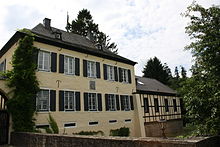Vischel Castle
The Vischel Castle , often referred to as Castle Vischel or house Vischel called, is a moated castle in the district Vischel the local church Mountain in the district of Ahrweiler ( Rheinland-Pfalz ). It is located above the Vischelbach valley between Berg and the Kreuzberg district of Altenahr .
The privately owned castle is a listed building .
history
Today's Vischel Castle probably goes back to a moated castle from the 9th century. In the Prümer Urbar , a list of goods from the Prüm Abbey from 893, extensive goods with a manor are listed in Vischel ( Wizssele ) . In the 11th century the abbey ceded its goods in Vischel in exchange to the Counts of Are . Vischel Castle was destroyed in 1115. On April 23, 1133 Embrico von Vischel, who was Ministeriale of Count Diederik von Are, died in the Rode monastery. In 1246 the property was donated to the Archbishopric of Cologne , which remained the owner until the Left Bank of the Rhine was taken by French revolutionary troops (1794) and the area was later annexed . From 1364 the lords of Gymnich were feudal takers on Vischel.
Today's moated castle, possibly standing on the old foundations, was built around 1829. The manorial house has five axes with a central risalit to the courtyard side. Since the estate had not been inhabited by the gentlemen at the time since the beginning of the 20th century, it was leased and was used for agriculture together with the surrounding meadows and fields until 1983. The castle, together with Gymnich Castle , came to Count Rudolf de Maistre via Count Wolff-Metternich and, after his death in 1968, to the Barons Holzschuher von Harrlach , an old Nuremberg patrician family that Gymnich sold in 1987 but still lives in Haus Vischel today .
The farm has been extensively restored since 1984 . The stables and barns were rebuilt while retaining the old facades, and the silos and tool shed were demolished. The mansion was prepared to accommodate guests and parties. Overall, the property now serves more representative purposes.
The former moat has been without water since the beginning of the last century and has lush vegetation. Three coats of arms are affixed to the palace facade: that of the de Maistre and von Gymnich families and that of the Wolff-Metternich family .
Reign of Vischel
The villages of Berg , Häselingen , Ober- and Unterkrälingen , Vellen and Vischel with the castle Vischel and the farms Springhof, Tungenburgerhof and Weißerath belonged to the rule Vischel, also Herrlichkeit Vischel . Until the end of the 18th century it was a subordinate rule of the Electorate of Cologne and part of the Altenahr office .
literature
- Jakob Rausch: Castle and Glory Vischel . In: Heimat-Jahrbuch / Kreis Ahrweiler 1959 . Schiffer, Rheinberg 1959, ISSN 0342-5827 , pp. 92-94 ( online ).
- Matthias Röcke: Castles and palaces on the Rhine and Ahr . ARE Verlag, Bad Neuenahr-Ahrweiler 1991, ISBN 3-9802508-3-0 , pp. 88-89.
- Harald Herzog, Rhenish Office for Monument Preservation: Vischel Castle . ( online )
- Volker Schulze: Berg, biography of a community in the Ahr-Eifel , Vektor-Verlag, Grafschaft 2011, ISBN 978-3-929304-59-6
- Annales Rodenses Kloster Rode zu Rolduc Kerkrade the year 1133.
Web links
- Entry on Schloss Vischel in the scientific database " EBIDAT " of the European Castle Institute
Individual evidence
- ^ Wilhelm Fabricius : Explanations for the historical atlas of the Rhine province, Volume 2: The map of 1789. Bonn 1898, p. 57.
Coordinates: 50 ° 32 ′ 33.2 " N , 6 ° 57 ′ 54.9" E

